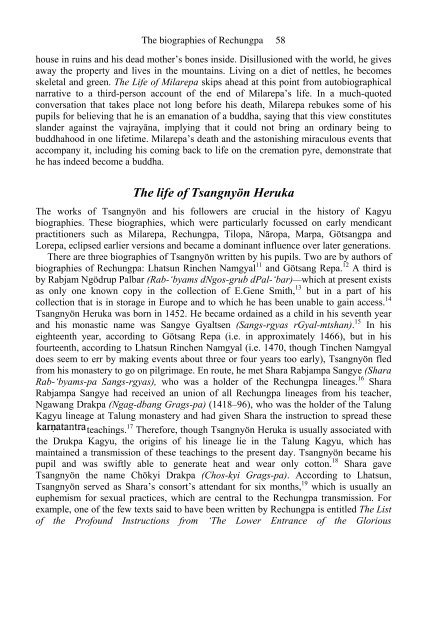The Biographies of Rechungpa: The Evolution of a Tibetan ...
The Biographies of Rechungpa: The Evolution of a Tibetan ...
The Biographies of Rechungpa: The Evolution of a Tibetan ...
You also want an ePaper? Increase the reach of your titles
YUMPU automatically turns print PDFs into web optimized ePapers that Google loves.
<strong>The</strong> biographies <strong>of</strong> <strong>Rechungpa</strong> 58<br />
house in ruins and his dead mother’s bones inside. Disillusioned with the world, he gives<br />
away the property and lives in the mountains. Living on a diet <strong>of</strong> nettles, he becomes<br />
skeletal and green. <strong>The</strong> Life <strong>of</strong> Milarepa skips ahead at this point from autobiographical<br />
narrative to a third-person account <strong>of</strong> the end <strong>of</strong> Milarepa’s life. In a much-quoted<br />
conversation that takes place not long before his death, Milarepa rebukes some <strong>of</strong> his<br />
pupils for believing that he is an emanation <strong>of</strong> a buddha, saying that this view constitutes<br />
slander against the vajrayāna, implying that it could not bring an ordinary being to<br />
buddhahood in one lifetime. Milarepa’s death and the astonishing miraculous events that<br />
accompany it, including his coming back to life on the cremation pyre, demonstrate that<br />
he has indeed become a buddha.<br />
<strong>The</strong> life <strong>of</strong> Tsangnyön Heruka<br />
<strong>The</strong> works <strong>of</strong> Tsangnyön and his followers are crucial in the history <strong>of</strong> Kagyu<br />
biographies. <strong>The</strong>se biographies, which were particularly focussed on early mendicant<br />
practitioners such as Milarepa, <strong>Rechungpa</strong>, Tilopa, Nāropa, Marpa, Götsangpa and<br />
Lorepa, eclipsed earlier versions and became a dominant influence over later generations.<br />
<strong>The</strong>re are three biographies <strong>of</strong> Tsangnyön written by his pupils. Two are by authors <strong>of</strong><br />
biographies <strong>of</strong> <strong>Rechungpa</strong>: Lhatsun Rinchen Namgyal 11 and Götsang Repa. 12 A third is<br />
by Rabjam Ngödrup Palbar (Rab-‘byams dNgos-grub dPal-‘bar)—which at present exists<br />
as only one known copy in the collection <strong>of</strong> E.Gene Smith, 13 but in a part <strong>of</strong> his<br />
collection that is in storage in Europe and to which he has been unable to gain access. 14<br />
Tsangnyön Heruka was born in 1452. He became ordained as a child in his seventh year<br />
and his monastic name was Sangye Gyaltsen (Sangs-rgyas rGyal-mtshan). 15 In his<br />
eighteenth year, according to Götsang Repa (i.e. in approximately 1466), but in his<br />
fourteenth, according to Lhatsun Rinchen Namgyal (i.e. 1470, though Tinchen Namgyal<br />
does seem to err by making events about three or four years too early), Tsangnyön fled<br />
from his monastery to go on pilgrimage. En route, he met Shara Rabjampa Sangye (Shara<br />
Rab-‘byams-pa Sangs-rgyas), who was a holder <strong>of</strong> the <strong>Rechungpa</strong> lineages. 16 Shara<br />
Rabjampa Sangye had received an union <strong>of</strong> all <strong>Rechungpa</strong> lineages from his teacher,<br />
Ngawang Drakpa (Ngag-dbang Grags-pa) (1418–96), who was the holder <strong>of</strong> the Talung<br />
Kagyu lineage at Talung monastery and had given Shara the instruction to spread these<br />
teachings. 17 <strong>The</strong>refore, though Tsangnyön Heruka is usually associated with<br />
the Drukpa Kagyu, the origins <strong>of</strong> his lineage lie in the Talung Kagyu, which has<br />
maintained a transmission <strong>of</strong> these teachings to the present day. Tsangnyön became his<br />
pupil and was swiftly able to generate heat and wear only cotton. 18 Shara gave<br />
Tsangnyön the name Chökyi Drakpa (Chos-kyi Grags-pa). According to Lhatsun,<br />
Tsangnyön served as Shara’s consort’s attendant for six months, 19 which is usually an<br />
euphemism for sexual practices, which are central to the <strong>Rechungpa</strong> transmission. For<br />
example, one <strong>of</strong> the few texts said to have been written by <strong>Rechungpa</strong> is entitled <strong>The</strong> List<br />
<strong>of</strong> the Pr<strong>of</strong>ound Instructions from ‘<strong>The</strong> Lower Entrance <strong>of</strong> the Glorious











